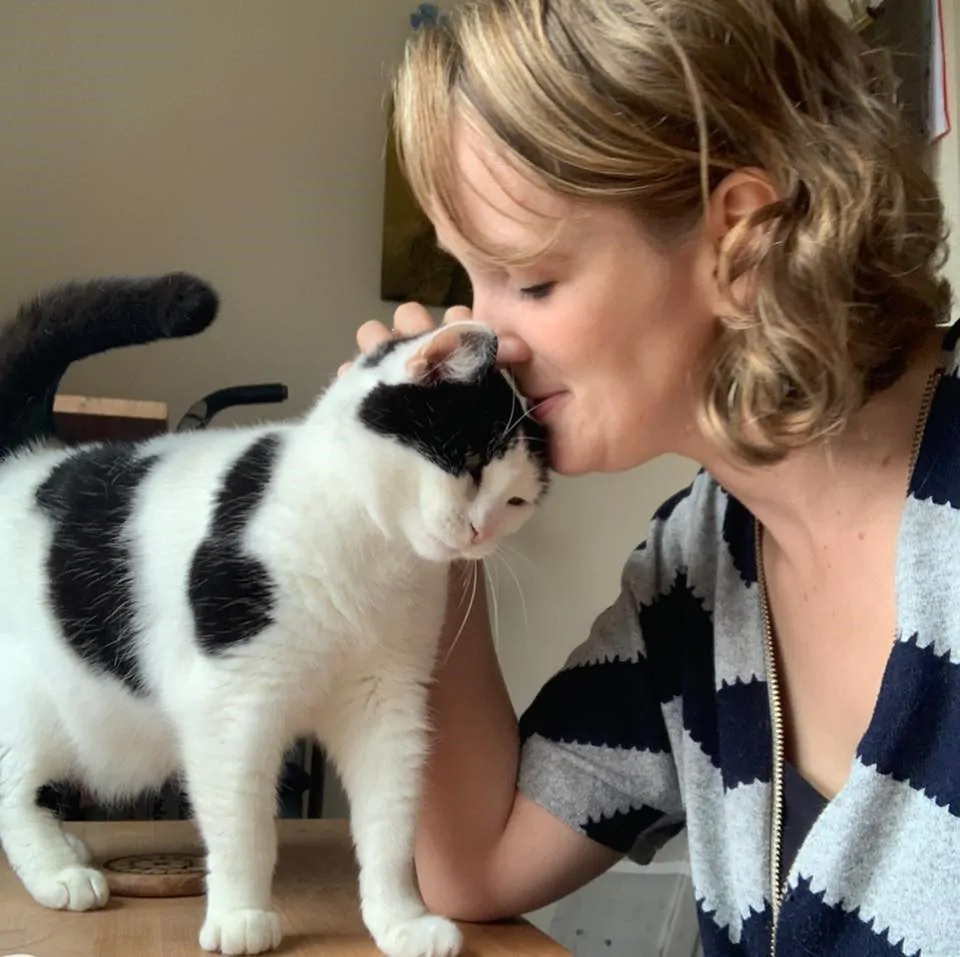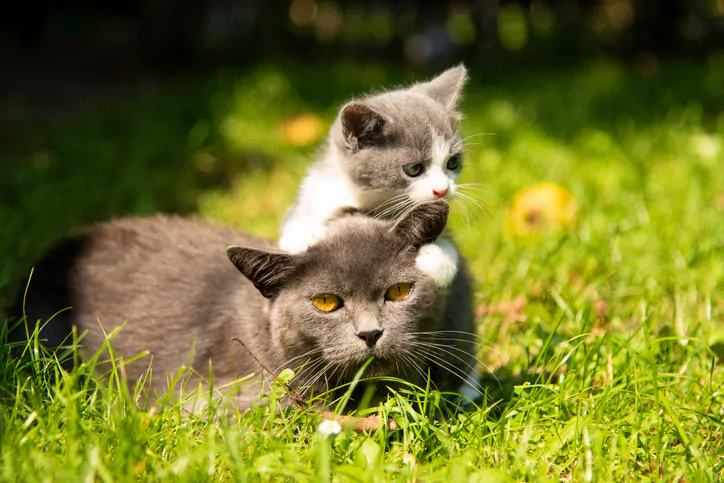
Introducing a kitten to a cat: How to do it the right way

Lucy Hoile
4 July 2025
Already have a resident cat but want to add another feline to the household? It’s important to make sure you do it the right way.
Below, expert cat behaviourist Lucy Hoile helps you understand if it’s a good choice for your cat and how to pick a suitable new companion. Lucy breaks down the steps for a positive introduction and how to set up long-term relationship success between your cats.
- How to tell if your cat wants another cat
- A step-by-step guide to introducing a kitten to a cat
- How to tell it’s going well between your kitten and cat
- Setting up your kitten and cat for long-term success
- More on kitten introductions
How to tell if your cat wants another cat
Cats are solitary animals and don’t have a biological need to live in a group. Many cats are more than happy to live by themselves and don’t need a friend.
This means you’ll need to think about what your resident cat’s relationships have been like with other cats. If your cat:
- Has been fighting with other cats outside the home it’s not a good idea to bring a kitten into the mix.
- Can be around others with no issues then this is usually a good sign they will accept another cat into the family.
- Is unwell due to a medical or behavioural issue, this needs to be resolved first before getting a kitten.
- Is mourning the loss of another family cat, let them finish grieving first and then decide if it’s right to do. Otherwise, you might cause them more stress.
On the other hand, if your first cat is still a kitten, it’s good to bring in another kitten as soon as possible. Kittens can be super demanding and attention-seeking so it can be helpful to give them a play buddy.
How to choose a compatible kitten for your cat
Kittens are usually more accepted than adult cats are. They’re not territorial at this age so a resident adult cat won’t see them as a threat.
But kittens are also more annoying as they want to play and chase the adult cat when they just want an easy life. So keep in mind that the introduction might go well but you might have setbacks a few months in.
The sex of your kitten makes no difference as long as they’re neutered. Compatibility of the kitten comes down to:
- Whether their personality and temperament complement your existing cat.
- If they’ve been properly socialised with people – you want to be able to get close and help the introduction process.

A step-by-step guide to introducing a kitten to a cat
Step one – Settle in your kitten
Your kitten needs to be settled in first before you can do anything else.
- Give your kitten their own room so they can get used to their new environment. This could be a spare room or bedroom.
- Go in there and hang out with them for a day or so, letting them approach you on their terms.
- Once they’re confidently coming out to eat and using the space, you can start introductions.
Step two – Scent swap
Scent is very important for cats as it’s how they recognise members of their social group. You can either:
- Swap over the bedding or scratch post of each cat and give to the other, or;
- Stroke each cat with a clean, soft cotton glove and leave it in the other cat’s room so they can explore it.
Once this is done, watch their behaviour to see how they react.
- Rubbing the items with their face or sleeping on the bed is a good sign.
- Ignoring them isn’t a bad sign as this can show neutrality.
- Double takes, hissing, or recoiling are signs of discomfort which means intros might take longer and need to go slowly.
Step three – Introductions with a barrier
Putting your kitten and adult cat together to ‘see how it goes’ isn’t recommended as a bad first meeting can make the process much harder.
Instead, you need to start with intros on either side of a barrier. Place a soft barrier – such as a fly screen or a dust door – between the cats.
- Be wary of baby gates as the cats can jump over or look through the bars.
- Make sure there’s plenty of space on their side so each cat can get away easily. It also gives you enough room to play with them and give them treats.
This initial intro phase is all about keeping things low-pressure and boring.
- Find a distance from the barrier that’s comfortable for your cat. They don’t need to be right up against the barrier, just close enough to see the kitten.
- Give them treats to encourage them closer, distract them away if needed, and reward them.
- A play session with toys can also be a great distraction and help keep things relaxed.
- Don’t give them their dinner by the barrier as having their normal meals shouldn’t be stressful.
- Don’t force the interaction by blocking off exits.
Once your kitten and cat start getting used to each other, you’ll see signs of frustration like pawing at the barrier. If you’re happy there are also no signs of tension, you can remove the barrier.
Step four – Introductions without a barrier
Continue to keep things low level once the barrier is gone. This means you should:
- Let your kitten and cat come and go as they please so they have some control over interactions.
- Watch and interact with both cats to manage things and distract them if needed.
- Set up your environment with plenty of high spaces and beds to entice them to relax and not compete with each other.
- Encourage them to settle down – you want them to be in the same room together but they don’t have to interact.
Gradually extend how long they spend together and gauge how they act to decide when you can leave them unsupervised.
How to tell it’s going well between your kitten and cat
Behaviours you’d expect to see from bonded cats include:
- Mutual grooming while snuggling together
- Body rubbing on each other
- Snuggling in the same bed and wrapped around each other
- Friendly play (no noises, claws out, hissing or growling)
Cats that are neutral towards each other will just stay out of each other’s way. It’s also fine if they share resources at different times.
Warning signs when introducing cats
Signs of tensions and conflict during an introduction between your kitten and cat include:
- Fighting – claws out, swiping, noises
- Hissing, growling, and yowling
- Relentless chasing or fighting by one cat against the other
- Negative body language – the targeted cat walking around with their belly to the ground, staring standoffs
Distracting your cat away with toys and treats can help to diffuse mild tension. But you might need to rehome one of your cats if you’re noticing a lot of negative behaviour and one or both are unhappy.
Setting up your kitten and cat for long-term success
Setting up for long-term success is all about focusing on your cats’ territory. Having plenty of resources spread throughout the home minimises the need for competition. Giving each cat their own resources can also help them avoid crossing paths if they don’t get on.
You want at least two of the following:
- Litter trays
- Beds
- Tall cat trees
- Feeding stations
For the 10 – 15 months, the pressure is on you to occupy your kitten. You don’t want your kitten’s energy focused on your adult cat. Your kitten is getting bigger but is still juvenile and super playful, which is a difficult combo. Keep them stimulated till they’ve grown up and started settling down.

More on kitten introductions
How to introduce a kitten to an older cat
When introducing a kitten to an older cat, your senior feline is the priority. You always need to make sure their needs are met. See them as a cat who needs comfort and an easy life.
- Create their own area where the kitten can’t pounce on them
- If possible, set up a separate room where the kitten can’t go
- Ideally, you’ll still get a second kitten so they can play with each other and your older cat won’t be targeted
How to introduce two cats when one is aggressive
If your cats are being aggressive they need separating. Start the intro process over again but go a lot more slowly.
The odd hiss isn’t the end of the world and doesn’t mean they can’t get along. You just need to move them apart or go back a step in the process and manage their intro more slowly. A cat who hisses is scared so you need to go at their pace.
If this still doesn’t work or there is a lot of aggression from one side then you need to think about rehoming. You can’t force a relationship and it’s not sustainable to stay in that kind of risky situation long term.
Introducing two kittens from different litters
Normally introducing two kittens from different litters goes smoothly. You can follow the same steps as introducing a kitten to an adult cat but move through them a lot faster.
Kittens will want to play with each other very quickly after meeting so be sure to encourage this and not slow things down!
Introducing a new cat to a multi-cat household
If you have one cat that is more comfortable than the others, introduce your kitten to them first. You can then later introduce the resident cats who might be more reluctant or nervous.
You also need to go at the pace of the cat who is most scared or you won’t be able to make progress.


